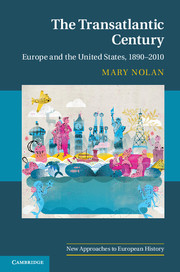Book contents
- Frontmatter
- Contents
- Illustrations
- Maps
- Tables
- Acknowledgments
- Introduction
- 1 An uncertain balance, 1890–1914
- 2 World War I: European crisis and American opportunity
- 3 Ambivalent engagement
- 4 The depression and transatlantic new deals
- 5 Strange affinities, new enemies
- 6 From world war to Cold War
- 7 Cooperation, competition, containment
- 8 Culture wars
- 9 The American Century erodes, 1968–1979
- 10 Renewed conflict and surprising collapse
- 11 A widening Atlantic
- 12 Imperial America, estranged Europe
- Suggested readings
- Index
- References
Introduction
Published online by Cambridge University Press: 05 November 2012
- Frontmatter
- Contents
- Illustrations
- Maps
- Tables
- Acknowledgments
- Introduction
- 1 An uncertain balance, 1890–1914
- 2 World War I: European crisis and American opportunity
- 3 Ambivalent engagement
- 4 The depression and transatlantic new deals
- 5 Strange affinities, new enemies
- 6 From world war to Cold War
- 7 Cooperation, competition, containment
- 8 Culture wars
- 9 The American Century erodes, 1968–1979
- 10 Renewed conflict and surprising collapse
- 11 A widening Atlantic
- 12 Imperial America, estranged Europe
- Suggested readings
- Index
- References
Summary
“There are at the present time two great nations in the world . . . the Russians and the Americans . . . each of them seems marked out by the will of heaven to sway the destinies of half the globe.” Alexis de Tocqueville’s prescient 1835 observation is often cited as a succinct summary of European-American relations in the twentieth century. According to the standard story, the multipolarity of the nineteenth century gave way to bipolarity by the middle of the twentieth century and then to unipolarity after 1989. As European power – economic, military, cultural, and moral – waned, America replaced Britain as the hegemonic nation in the global capitalist order, and European culture, politics, and economics were Americanized. As European colonial empires fractured and fell, new American forms of global economic and political integration and dominance emerged. Whereas Europe had once developed the Western values shared by America, America came to define the transatlantic commitment to liberal democracy and consumer capitalism. If the nineteenth century was European, the twentieth was American.
Tocqueville’s observation and sweeping narratives of the decline of Europe and rise of America capture elements of the shifting relationship between Europe and America in the twentieth century, but they do justice neither to the complexity of the exchanges of goods, people, institutions, and ideas in both directions across the Atlantic nor to the ambivalent and contradictory attitudes of Europeans and Americans toward one another. A history of shifting transatlantic power relations, of provisional outcomes and ongoing indeterminacies, of cooperative projects and competing visions of capitalism, modernity, and empire cannot be reduced to the inevitable triumph of the United States; that history is much more nuanced, contingent, and contradictory. It begins with the stop-and-start rise of American influence in Europe in the early decades of the twentieth century, continues with the mid-century assertion of American hegemony in all fields, and then proceeds to the slow erosion of American economic, cultural, and political power from the1970s on and the emergence of an integrated and more autonomous Europe. American economic might did not automatically translate into political power or cultural influence, and hard military and diplomatic power and soft economic and cultural power did not always move in tandem. Transatlantic perceptions of shared interests, incompatibilities, and animosities were seldom clear-cut or stable.
- Type
- Chapter
- Information
- The Transatlantic CenturyEurope and America, 1890–2010, pp. 1 - 9Publisher: Cambridge University PressPrint publication year: 2012

